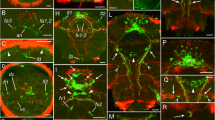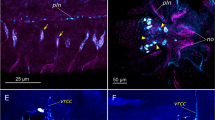Summary
In the posterior part of the brain of the protandric polychaete Ophryotrocha puerilis neurosecretory cells form prominent axon terminals. The terminals are arranged in two complexes. The perikarya of these presumably monopolar neurons are scattered in the anterior part of the cerebral perikaryal layer. In females the terminals store large amounts of neurosecretory material. It has been suggested earlier that neurosecretions of the terminals may play a role during sex reversal from females to males. Application of histamine caused the release of neurosecretory material from the respective terminals in females. However, this discharge was not followed by sex reversal. Application of reserpine had no influence on the terminals. Neither by in vivo observation nor by ultrastructural analysis any effect of reserpine on the terminal complexes could be observed. In isolated terminals filled with neurosecretory material from females, catecholamines could not be detected by HPLC. Also, polyclonal antibodies against dopamine did not stain the terminal complexes. Furthermore, the complexes did not develop any fluorescence after glyoxylic acid treatment. Therefore, the present results contradict the hypothesis that the neurosecretory material of the respective axon terminals is catecholaminergic and that it is involved in sex differentiation. The function of the secretory neurons studied here remains unclear.
Similar content being viewed by others
Abbreviations
- AT:
-
axon terminal
- CA:
-
catecholamine(s)
- DA:
-
dopamine
- DAB:
-
diaminobenzidine
- GA:
-
glyoxylic acid
- GIF:
-
glyoxylic acid-induced fluorescence
- LY:
-
Lucifer Yellow
- MB:
-
methylene blue
- NSM:
-
neurosecretory material
- OTH:
-
ootropic hormone
- TC:
-
terminal complex
References
Fahimi HD (1975) Fine-structural cytochemical localisation of peroxidase activity of catalase. In: Glick D, Rosenbaum RM (eds) Techniques of biochemical and biophysical morphology vol 2. Wiley, New York, pp 197–245
Geffard M, Buijs RM, Seguela P, Pool CW, Moal M le (1984) First demonstration of highly specific and sensitive antibodies against dopamine. Brain Res 294:161–165
Grothe C (1982) Axon terminals with unusual vesicles in the brain of the polychaete, Ophryotrocha puerilis. Cell Tissue Res 226:237–240
Grothe C (1983) Experimentelle and morphologische Untersuchungen des neuroendokrinen Systems bei dem Polychaeten Ophryotrocha puerilis (Clap & Mecz 1869) Dissertation, FU Berlin
Grothe C, Pfannenstiel HD (1986) Cytophysiological study of neurosecretory and pheromonal influences on sexual development in Ophryotrocha puerilis (Polychaeta, Dorvilleidae). Int J Invert Reprod Dev 10:227–239
Grothe C, Seidl K, Pfannenstiel HD (1987) Cytochemical and biochemical characterization of neurosecretory material in the brain of an annelid, Ophryotrocha puerilis (Polychaeta). Gen Comp Endocrinol 68:1–5
Lagunoff D (1975) The localisation of histamine in cells. In: Glick D, Rosenbaum RM (eds) Techniques of biochemical and biophysiological morphology, vol 2. Wiley, New York, pp 283–305
Lindvall O, Björklund A (1974) The glyoxylic acid fluorescence histochemical method: a detailed account on the methodology for visualisation of central catecholamine neurons. Histochemistry 39:97–127
Müller T, Unsicker K (1981) High-performance liquid chromatography with electrochemical detection as a highly efficient tool for studying catecholaminergic systems. I. Quantification of noradrenaline, adrenaline, and dopamine in cultured adrenal medullary cells. J Neurosci Methods 4:39–53
Pfannenstiel HD (1971) Zur sexuellen Differenzierung des Borstenwurms Ophryotrocha puerilis. Naturwissenschaften 58:367
Pfannenstiel HD (1972) Eine neue Ophryotrocha-Art (Polychaeta, Eunicidae) aus Japan. Helgoländer Wiss Meeresunters 23:117–124
Pfannenstiel HD (1973) Zur sexuellen Differenzierung von Ophryotrocha puerilis (Polychaeta, Eunicidae). Mar Biol 20:245–258
Pfannenstiel HD (1975) The role of the prostomium for the sexual differentiation in the polychaetes Ophryotrocha puerilis Clap Mecz 1869 and O. notoglandulata Pfannenstiel 1972. Pubbl Stan Zool Napoli [Suppl] 39:542–549
Pfannenstiel HD, Grothe C (1988) Neurosecretory elements. In: Westheide W, Hermans CO (eds) The ultrastructure of polychaeta. Microfaune Marina 4:111–120
Pfannenstiel HD, Spiehl D (1987) Dopamine induces sex reversal in females of Ophryotrocha puerilis (Polychaeta). Cell Differ 20 [Suppl] 84
Pfannenstiel HD, Schlawny A, Hamann T, Müller M, Rhode B, Spiehl D (1990) Dopamine and male-female differentiation in a hermaphroditic polychaete. In: Epple A, Scanes CG, Stetson MH (eds) Progress in comparative endocrinology. Wiley-Liss, New York, 219–225
Reisinger E (1936) Zur Exkretionsphysiologie von Ophryotrocha puerilis Claparède & Metschnikoff. Thalassia 2:2–24
Schlawny A (1989) Experimentelle und morphologische Untersuchungen des zentralen und peripheren Nervensystems bei dem Polychaeten Ophryotrocha puerilis (Clap & Mecz 1869). Dissertation, FU Berlin
Schlawny A, Hamann T, Müller MA, Pfannenstiel HD (1991) The catecholaminergic system of an annelid (Ophryotrocha puerilis Polychaeta). Cell Tissue Res (in press)
Spiehl D, Grothe C, Müller M, Schlawny A, Pfannenstiel HD (1989) Dopamine is involved in sexual differentiation of the protandric polychaete, Ophryotrocha puerilis. Gen Comp Endocrinol 74:274–275
Sternberger LA (1970) The unlabeled antibody method of immunocytochemistry. J Histochem Cytochem 18:315
Stewart W (1981) Lucifer dyes-highly fluorescent dyes for biological tracing. Nature 292:17–21
Author information
Authors and Affiliations
Rights and permissions
About this article
Cite this article
Schlawny, A., Hamann, T., Müller, M.A. et al. Cytophysiology of neurosecretory axon terminals in the brain of an annelid (Ophryotrocha puerilis, Polychaeta). Cell Tissue Res 264, 339–345 (1991). https://doi.org/10.1007/BF00313972
Accepted:
Issue Date:
DOI: https://doi.org/10.1007/BF00313972




